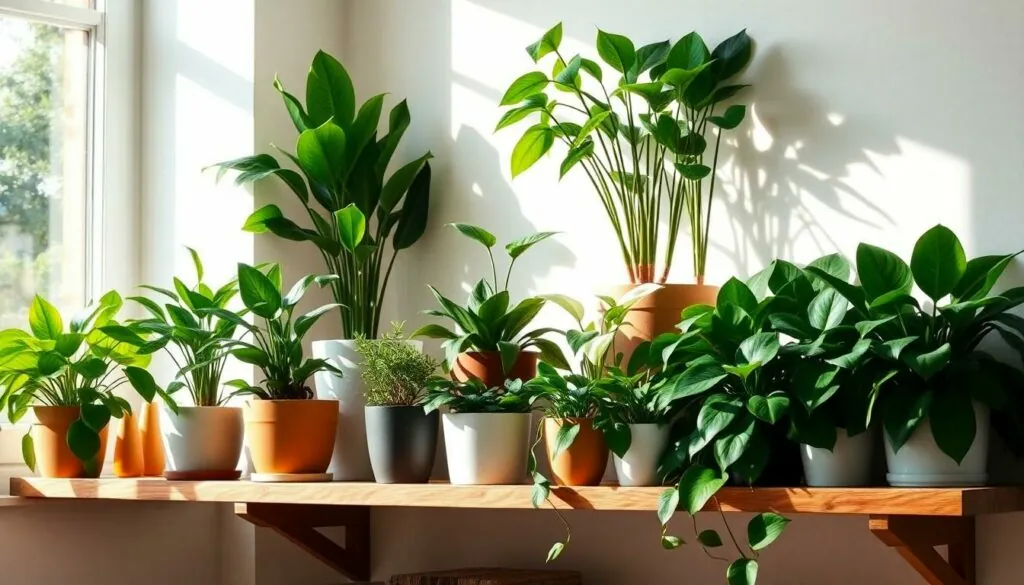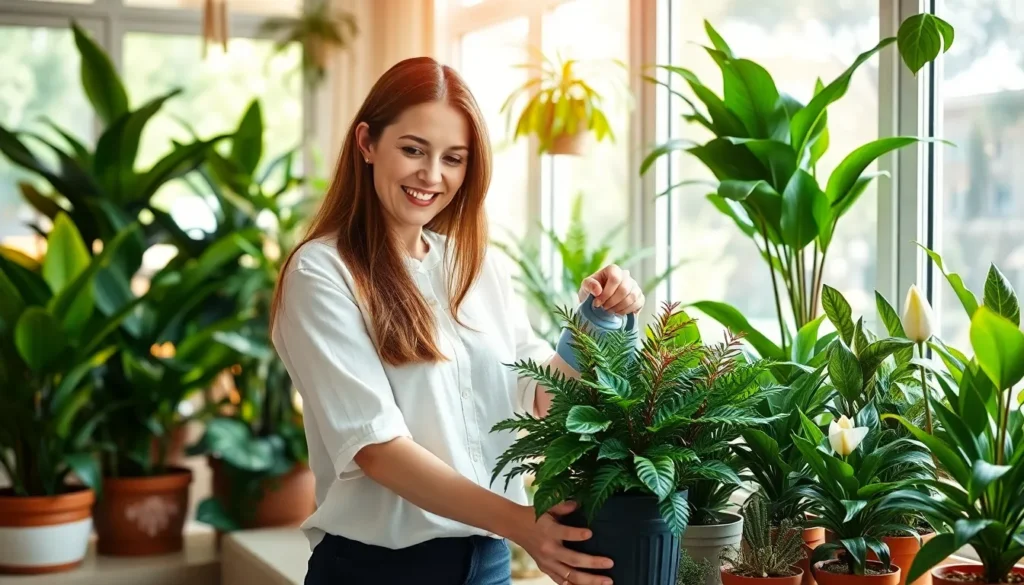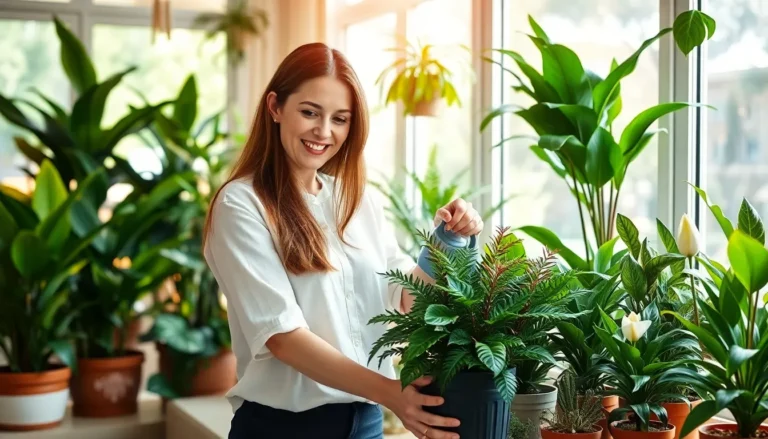Table of Contents
ToggleBringing a bit of greenery into a home isn’t just about aesthetics; it’s about creating a cozy oasis that breathes life into any space. House plants have become the ultimate home accessory, transforming dull corners into vibrant retreats. From the resilient snake plant to the charming pothos, these green companions not only look good but also improve air quality and boost mood. Who wouldn’t want a plant that’s both a roommate and a mood-lifter?
Most Popular House Plants
Snake plants stand out as a favorite among house plant enthusiasts. Known for their striking leaves, they thrive in low light and require minimal watering. Pothos plants are also highly favored due to their trailing vines and adaptability. These plants can flourish in various lighting conditions, making them perfect for busy individuals.
Spider plants, with their arching leaves and small offshoots, offer a playful touch to any room. They thrive in indirect sunlight and tolerate occasional neglect. ZZ plants, admired for their glossy foliage, require little care and can survive in low light, proving their versatility in home environments.
Peace lilies bring elegance with their beautiful white blooms. These plants prefer shaded areas and enjoy slightly moist soil, enhancing aesthetic value. Rubber plants boast robust leaves and can grow quite tall, which adds a bold statement to decor.
Fiddle leaf figs capture attention with their large, violin-shaped leaves. These popular house plants require bright, indirect light and regular watering for optimal growth. In contrast, succulents appeal through their unique shapes and low maintenance needs. They flourish in well-drained soil and thrive in bright sunlight, making them ideal for windowsills.
Each of these popular house plants not only beautifies indoor spaces but also contributes to improved air quality. Incorporating a variety of these plants creates a lively atmosphere. They serve as valuable companions, enriching both the visual and emotional appeal of any home.
Benefits of House Plants

House plants offer numerous advantages that range from health improvements to aesthetic enhancements. They play a crucial role in creating a pleasant indoor environment.
Improved Air Quality
House plants actively contribute to improved air quality by filtering toxins. They can remove harmful substances like formaldehyde and benzene, making spaces healthier. Studies show that having at least one plant in a room can boost overall air purification. For example, the peace lily excels in absorbing indoor pollutants. The snake plant absorbs carbon dioxide and releases oxygen, aiding respiratory health. These plants enhance oxygen levels, creating an invigorating atmosphere for inhabitants and guests alike.
Enhanced Aesthetics
House plants enhance aesthetics through their diverse beauty and textures. They introduce natural elements that soften interior spaces. Selecting a combination of colors and shapes creates visual interest and adds depth to design. A fiddle leaf fig can serve as a striking focal point, while pothos adds trailing greenery that brightens corners. Incorporating various plants creates vibrant, inviting spaces. These visual upgrades lead to elevated moods and can inspire creativity, transforming homes into relaxing retreats.
Top House Plants to Consider
Incorporating popular house plants enhances any home. These plants not only beautify spaces but also improve air quality.
Snake Plant
Snake plants thrive in low light conditions. This resilient plant requires minimal care, making it suitable for beginners. Its tall, upright leaves feature striking patterns, adding a modern touch to interiors. Furthermore, snake plants improve indoor air quality by releasing oxygen at night, promoting better respiratory health.
Pothos
Pothos is known for its adaptability, thriving in various lighting conditions. This vine-like plant can grow in low to bright indirect light, making it versatile for different spaces. Its heart-shaped leaves, often variegated with cream and yellow tones, create visual interest. Pothos also excels at removing indoor toxins, contributing to a healthier living environment.
Spider Plant
Spider plants offer a distinctive look with their arching green leaves and tiny white flowers. They are easy to care for and tolerate a range of conditions. Notably, spider plants produce “baby” plants that can be propagated easily, enabling home gardeners to expand their collection. These plants also play a role in improving air quality by filtering pollutants.
Peace Lily
Peace lilies are popular for their elegant white blooms and lush green foliage. They thrive in low to moderate light conditions, making them ideal for shaded areas. This plant excels at filtering harmful pollutants like formaldehyde and benzene from the air. With minimal care and regular watering, peace lilies become a striking focal point in any room.
Care Tips for House Plants
Maintaining house plants requires specific attention to their needs. Proper care enhances their health and longevity.
Watering Requirements
Indoor plants demand varying amounts of water. Most prefer thorough watering, allowing excess to drain out to prevent root rot. A general guideline is to water when the top inch of soil feels dry. Spider plants thrive with regular moisture, while ZZ plants tolerate drought better. Checking the soil moisture regularly ensures that no plant goes underwatered or overwatered.
Light Conditions
House plants benefit from distinct light exposure. Snake plants flourish in low light, making them suitable for any corner of a room. Conversely, fiddle leaf figs require bright, indirect sunlight to maintain their vibrant leaves. Observing the light preferences of each plant type helps maximize growth and health. Ensuring the right balance of light prevents leggy growth and yellowing leaves.
Fertilizing and Repotting
Fertilizing supports healthy growth in house plants. During the growing season, a balanced fertilizer applied monthly boosts overall vitality. Repotting every one to two years gives roots ample space to expand. Additionally, select a slightly larger pot with fresh soil to provide essential nutrients. Identifying when roots emerge from drainage holes signals it’s time to repot and refresh the plant’s environment.
Incorporating house plants into home decor is a simple yet effective way to enhance both the beauty and health of indoor spaces. With options like snake plants and pothos, anyone can find the perfect plant that fits their lifestyle and aesthetic preferences. These plants not only purify the air but also add a touch of nature that uplifts mood and creates a serene atmosphere.
Whether someone is a seasoned plant parent or just starting their journey, the variety of popular house plants available ensures there’s something for everyone. By choosing the right plants and following care tips, individuals can enjoy the numerous benefits that come with having greenery indoors. Embracing house plants is more than just a trend; it’s a step towards a healthier and more inviting home environment.







